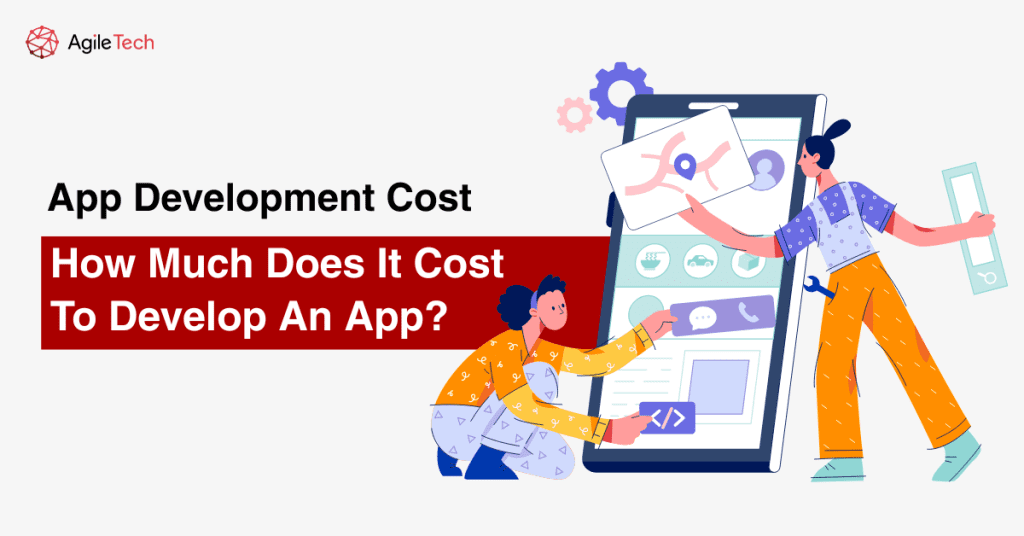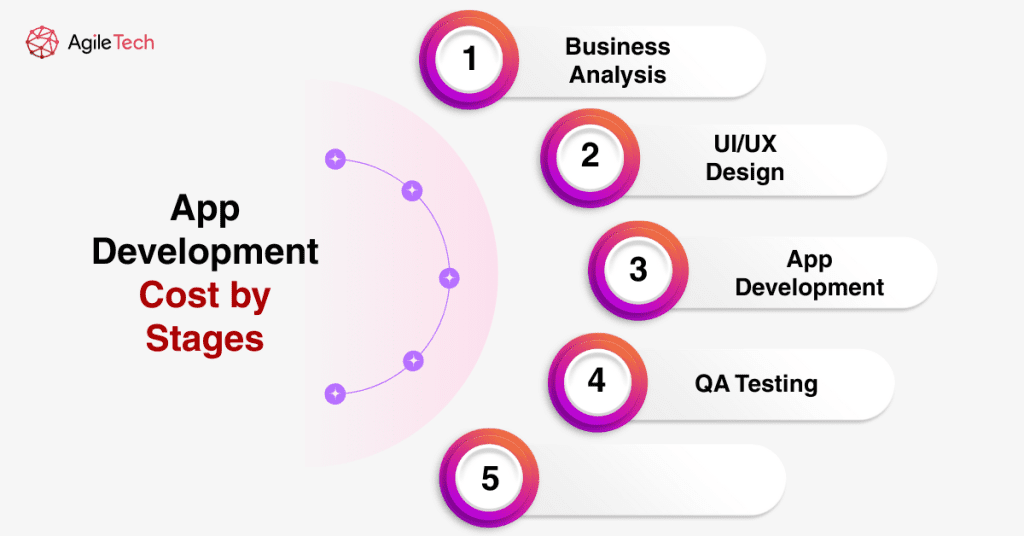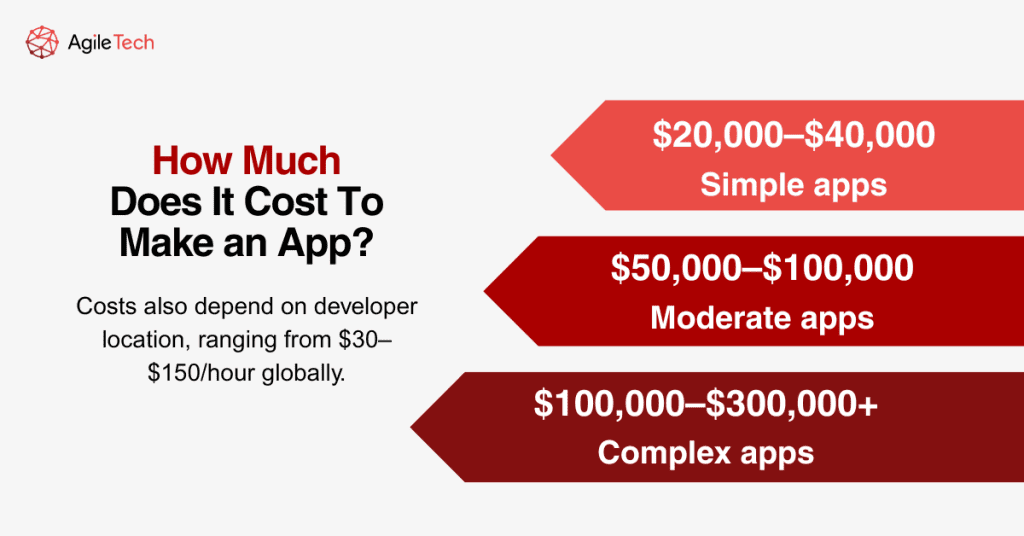App Development Cost: How Much Does It Cost To Develop An App?
In today’s hyper-digital world, mobile apps are the gateway to how businesses interact with customers, streamline operations, and deliver value. From startups disrupting entire industries to enterprises optimizing internal workflows, apps are integral to modern business strategies. But while the idea may seem straightforward, one question always looms large: How much does it cost to develop a mobile app?

Unfortunately, there is no one-size-fits-all answer. App development costs can range from a few thousand dollars to several hundred thousand, depending on a mix of variables including the platform, feature set, design, development approach, and the pricing model you choose. In this guide, we’ll break down the key components that affect app development cost and help you build a reliable budget for your digital product.
1. App Development Cost: Major Factors
Developing a mobile app is a multi-phase project that involves design, coding, testing, and deployment. Every decision you make, starting from the platform to the number of features, has a direct impact on the overall cost.
1.1. Platform (iOS vs. Android)
The choice between developing for iOS, Android, or both is one of the earliest and most crucial decisions you’ll make. iOS apps are often faster and more cost-effective to build because of fewer device variations and stronger user consistency. However, Android dominates in global market share, especially in emerging regions, making it a necessary option for broader reach.
If your target audience includes both Android and iOS users, you may need to build and maintain two separate codebases unless you choose a cross-platform development solution, which we’ll discuss shortly. Developing for multiple platforms will naturally increase both development time and cost.
1.2. Native App, Hybrid App, and Flutter
The development method you select, native, hybrid, or cross-platform, will also greatly influence your budget.
Native apps are built specifically for one operating system using platform-specific languages like Swift for iOS or Kotlin for Android. While native apps offer the best performance, responsiveness, and access to hardware features, they also require two separate development efforts if you want to launch on both platforms, effectively doubling the time and cost.
Hybrid apps are built using web technologies like HTML, CSS, and JavaScript, and then wrapped in a native container. They allow you to write code once and deploy it everywhere, but they often come with performance trade-offs, especially when complex animations or device-specific features are involved.
Flutter, a cross-platform toolkit by Google, is gaining popularity as a hybrid alternative that doesn’t compromise performance. Flutter apps compile to native code, which makes them faster and more efficient than traditional hybrid apps, while still maintaining a single codebase for both iOS and Android. This choice can reduce development costs by 30–40% without sacrificing user experience.
1.3. Complexity of Features
One of the most influential factors in app development cost is the complexity of the features you want to include. A basic app with static content, a simple form, and a user login feature is relatively inexpensive to develop. But as you add more advanced functionalities like GPS tracking, real-time messaging, in-app purchases, third-party API integration, or machine learning algorithms, the cost can escalate quickly.
Moreover, certain features require specialized expertise or extended testing. For instance, developing a custom recommendation engine or integrating payment gateways with multi-currency support adds not only development effort but also rigorous security requirements and compliance work.
1.4. UI/UX Design
Great design is more than just visual polish it’s how users interact with your app. Intuitive navigation, appealing visuals, fast loading animations, and thoughtful micro-interactions all influence user retention and engagement. However, high-quality design also comes with its own costs.
If you opt for custom illustrations, detailed transitions, or gamified interfaces, expect to invest more in design hours. The more screens and user flows you need to prototype and iterate on, the higher your budget must be. While design might seem like an area where costs could be trimmed, it’s often a false economy poor design leads to high churn and low app store ratings.
1.5. Software Outsourcing Company
Another key factor in cost is who builds your app. You can choose to hire a freelance developer, build an in-house team, or outsource to a professional software development company.
Outsourcing is often the most cost-effective option, especially when working with offshore teams in countries like Vietnam, India, Ukraine, or Poland. These regions offer access to highly skilled developers at a fraction of the rates you’d pay in the US or Western Europe.
More importantly, partnering with a seasoned app development company gives you access to a complete team, including project managers, designers, developers, and testers working together under one roof. This ensures smoother communication, fewer delays, and a product that aligns with business goals.
2. How To Define App Development Costs
Estimating the cost of app development is not just about hourly rates. You’ll need to consider the total time required to complete each phase of the app and then multiply that by the hourly cost of your development team. This approach—known as time-based estimation—is the industry standard for building realistic budgets.
For example, a login feature may take 8–12 hours, while a real-time chat module may take 80–120 hours. Once all modules are estimated, you’ll have a clearer picture of how the costs accumulate.
In early planning stages, using a mobile app cost calculator can be helpful. These tools allow you to input features, choose platforms, and get ballpark figures. However, while useful for benchmarking, they can’t account for the unique aspects of your product. A proper discovery workshop or consultation with a software partner is essential for accuracy.
3. Define the Right Price Models
Choosing a pricing model is as important as choosing your developer. It determines how flexible your project can be and how financial risks are distributed.
3.1. Fixed Price
With a fixed price model, you agree on a total budget upfront based on a clearly defined scope of work. This model works well for smaller projects with minimal changes, such as MVPs or proof-of-concepts. The benefit is cost predictability. The downside is a lack of flexibility; any scope changes or new features require change requests, which can lead to delays and renegotiations.
3.2. Time & Materials
Time and materials (T&M) is a more agile-friendly model where you pay based on the actual time and resources spent. This model allows you to iterate on feedback, adjust priorities, and make improvements throughout the project lifecycle. T&M is ideal for complex projects where requirements may evolve or aren’t fully defined at the outset.
3.3. Dedicated Team Development
For long-term or highly scalable products, hiring a dedicated team makes sense. You essentially “rent” a team that works exclusively on your project. This model offers deep integration with your business, quick response to changes, and full control over product direction. While this approach is more expensive month-to-month, it’s cost-effective over time due to reduced handovers and better knowledge retention.
4. App Development Cost by Stages

The total development cost of an app can be broken down into multiple key stages, each contributing a distinct portion to the final figure.
4.1. Business Analysis
Every successful app starts with a strategic blueprint. Business analysis involves researching your market, defining user personas, and preparing technical requirements. This phase is essential for preventing miscommunication and reducing rework later on. Business analysis can represent around 5–10% of your total budget.
4.2. UI/UX Design
Design work begins with wireframes and low-fidelity prototypes and evolves into high-fidelity mockups and interactive elements. The more features and screens your app has, the more time designers will spend crafting a cohesive experience. On average, expect to allocate about 10–15% of your budget to the design stage.
4.3. App Development
This is the core phase, where developers turn your designs and business requirements into a functional product. Frontend developers focus on what users see and interact with, while backend developers handle servers, APIs, data storage, and logic. This phase often takes up 40–50% of the total cost, depending on complexity and team size.
4.4. QA Testing
No app is ready for release without rigorous quality assurance. QA testers run functionality tests, usability tests, performance tests, and security audits to ensure the app works as expected across different devices and use cases. The testing phase may require 15–25% of your budget, especially if automated tests are implemented.
4.5. Project Management
Good project managers ensure the app is delivered on time, within budget, and aligned with your expectations. They coordinate teams, track milestones, manage risks, and keep communication flowing. Project management usually accounts for 10–15% of the total cost and is often included in full-service development packages.
5. Factors in Additional Costs
Beyond development, several ongoing and hidden costs can affect your budget. You’ll need to pay for app store registration fees—$99/year for Apple and a one-time $25 fee for Google Play. Hosting fees, especially if you’re using cloud services like AWS, GCP, or Azure, will vary based on traffic and storage.
Ongoing maintenance and updates typically cost around 15–20% of the initial development cost annually. You’ll also incur costs for bug fixing, scaling, user analytics tools, and integrating third-party services like push notifications or payment gateways.
If your app deals with sensitive data or operates in regulated industries (like finance or healthcare), you may need to invest in compliance, additional security layers, and legal documentation.
| App Type | Key Features | Estimated Time | Estimated Cost (USD) | Recommended For |
|---|---|---|---|---|
| Simple App | Basic login, static content, simple UI, no backend or integrations | 2–3 months | $20,000 – $40,000 | MVPs, internal tools, landing apps |
| Moderate Complexity | User accounts, push notifications, map integration, payments, backend services | 4–6 months | $50,000 – $100,000 | Startups, growing digital products |
| High Complexity App | Real-time chat, media streaming, AI/ML, custom backend, high security | 6–9+ months | $100,000 – $300,000+ | Scalable platforms, enterprise apps |
| Cross-Platform App | Built with Flutter or React Native for iOS & Android, shared codebase | 3–5 months | 30%–40% lower than native app | Fast time-to-market, budget optimization |
| Enterprise App | Integration with ERP/CRM, advanced analytics, multi-role access, API ecosystem | 6–12+ months | $200,000 – $500,000+ | Large companies, internal infrastructure |
6. How Much Does It Cost To Make an App?

So, what’s the final number? While every app is different, here’s a general breakdown:
- A simple app (login, basic UI, static content) costs between $20,000–$40,000.
- A moderately complex app (chat, maps, payments, user profiles) costs around $50,000–$100,000.
- A complex app (AI integration, real-time syncing, custom backend, high scalability) can range from $100,000–$300,000+.
Your total also depends on where your developers are based. In the U.S., hourly rates can exceed $150. In Eastern Europe or Southeast Asia, you might pay $30–$60/hour for equally skilled developers.
Conclusion
App development is an investment, not just in code, but in your product’s future. Understanding the many factors that contribute to development costs helps you make smarter decisions, avoid common pitfalls, and plan with clarity. From platform and features to design and development models, each choice impacts your timeline, budget, and final product quality.
If you’re looking to build a mobile app that balances innovation, scalability, and cost-efficiency, partnering with the right development company can make all the difference. At AgileTech, we specialize in end-to-end mobile app development tailored to your business goals, timeline, and budget. Let’s bring your idea to life intelligently, affordably, and successfully.
